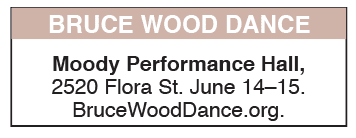Garrett Smith created ‘Forbidden Paths,’ his first politically-driven dance piece, only after coming to Dallas and discovering the talent of the Bruce Wood dancers. (Photo by Arnold Wayne Jones)
Out choreographer Garrett Smith mounts a potent new work for Bruce Wood Dance’s season premiere
ARNOLD WAYNE JONES
Executive Editor | jones@dallasvoice.com
Ever since the death of its founder — five years ago this week, in fact — Dallas’ Bruce Wood Dance has threaded an artistic needle, carrying on Wood’s legacy (he created more than 60 original works before his death at 53) while expanding the company’s repertoire with new works. In what may be a first for the troupe, its upcoming show, entitled Embrace, will mount two non-Wood pieces, one a world premiere commission by Garrett Smith. And the direction the dance took was as surprising to Smith himself as it will be to audiences.
There’s always a leap of faith when it comes to working with new choreographers joining the company for the first time, but BWD’s new artistic director, Joy Bollinger, saw something in Smith’s prior work that she felt would be a good fit.
 “I was attracted to his musicality and partnering work,” Bollinger observes. So she invited the former Houston resident to join the team without any real preconditions. The dancers didn’t know what to expect until Smith arrived … and, frankly, neither did he.
“I was attracted to his musicality and partnering work,” Bollinger observes. So she invited the former Houston resident to join the team without any real preconditions. The dancers didn’t know what to expect until Smith arrived … and, frankly, neither did he.
Up until a few days before arriving in Dallas, Smith — for six years, a principal dancer with the Norwegian National Ballet, but who became a freelance choreographer only about a year ago — had been preoccupied with a large commission he was working on in Norway, and simply hadn’t had time to focus on what he would do in Dallas, until an Instagram post sparked his creativity.
“The concept is based on something I didn’t know about [until a few months ago] — that dance is prohibited in Iran, especially in Tehran, as well as many places around the Middle East. The word ‘dance’ cannot even be printed in media,” Smith explains.
He became aware of it initially when he posted a rehearsal video on social media for the Norwegian piece, and one of his followers commented on it in Farsi. He wrote back that he didn’t understand Farsi; that’s when dozens of translations came flooding in… as well as commentaries about the underlying situation.

Smith’s partner work was one reason artistic director Joy Bollinger commissioned him for this world premiere. (Photo by Brian Guilliaux)
Still, until the morning of the first day of rehearsal in Dallas, the idea was still germinating; he discovered and settled on the music he would use for the piece, most of it Persian, moments before the dancers showed up.
“I’ve never used this kind of music before — I’m more likely to use Vivaldi or Philip Glass,” he says. But he felt an obligation to tap into the situation in the Middle East specifically, even though the themes are more universal.
“It can be related to any other country or place, but I was really moved by [the news from Iran],” he says. “Everyone should be able to express themselves through dance. This is my first time doing something politically-driven — I’m just not that political. But I hope my dance would help bring attention to this issue. That’s the driving force of the piece — that I have the power to give them hope.”
And what attention it has brought already. Within the first two weeks of posting his first BWD rehearsal video with music, his social media presence grew by 4,000 followers… almost all of them from Iran.
“The struggle is real,” Smith says. “People learning to dance in secret from YouTube videos.”
For this piece, called Forbidden Paths, Smith uses hoodies to represent hajabs and shows plenty of skin to suggest a kind of freedom of the body that transcends man-made laws. It overflows with speed, physicality and street energy. It is, in some ways, unlike most of Wood’s own work, but in a more fundamental way totally in tune with his stunning originality. And he has nothing but praise for the company.
“I consider myself a versatile choreography, and I’m not interested in ‘classical’ bodies — I like to see what each dancer is good at,” Smith says. And he was bowled over when he got to BWD.
“I create a piece when I get to the companies and can see what [the talent level is]. When I got [to Bruce Wood Dance], there was not one dancer I wasn’t interested in working with, so it had to be an ensemble piece. I think this company is vastly underrated — there is no reason why they shouldn’t be working with the best choreographers in the world today. They could be all over the map.” █













